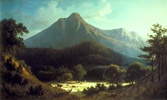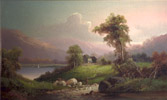The art
Schafer's paintings typically have three distinct appeals. The primary one is a strong artistic merit, arising from a good sense of composition and color, and an overall feeling of having succeeded in capturing the impression and mood of the original scene. Second, many of his paintings represent a bygone era, depicting native inhabitants, wilderness, wildlife, and undeveloped locales that have long since disappeared. This second appeal goes beyond simple historical interest; it refers to a simpler time and to the lost frontier, but from the hand of an artist who got there in time to capture it. Finally, many of Schafer's paintings are of landmarks of high iconic value: the Golden Gate, Mount Shasta, Mount Hood, Yosemite Valley, Monterey Bay. These landmarks are immediately recognizable by a large audience today, and that recognition produces the third appeal. All Schafer paintings have at least one or two of these features, and many have all three.
General style
Schafer's overall style is that of the nineteenth-century American realist landscape tradition, taking maximum advantage of the dramatic western American landscape and with a strong element of naturalism--a preference to capture the impression of an object such as a tree rather than to provide photographic detail of it.1 Schafer's paintings depict actual appearances of nature, especially as to color, texture, clutter, and light. There is little evidence of idealization of scene content in the form of careful balance or cleaning up woodland clutter. On the other hand, many of his pictures appear to be composites, with a well-known landmark in the center but high framing crags or a small foreground waterfall borrowed from another site. As part of the same artistic license, Schafer exercises a choice of vantage point for each scene so that the apparently natural appearance includes interesting proportions of light and dark, of forest and mountain, and of division of the canvas into sections of distinct character. The paintings of the Pacific coast, with their horizontal format, damp, foggy atmosphere, and feeling of solitude, could find their way into an exhibition of Luminist work, while the eastern forest scenes of woodlands with bright autumn color are sufficiently similar to work of the Hudson River school that absent the western landscapes Schafer might be thought to be a late member of that school.
 |
| [View of Mount Tamalpais] |
A common compositional device seen in most of Schafer's mountain landscapes is a foreground/middle range division, represented by a mountain ridge or a line of treetops, along a diagonal line from an upper corner to the lower center or the opposite lower corner. Another frequent compositional device is to place the nearest part of the foreground in shadow, leaving the eye to be first attracted to a bright, sunlit area in the middle of the painting, rather than nearby objects that perspective requires to be larger. At the same time, the dark foreground is usually roughly textured, creating, together with vertical trees or cliffs on one or both sides, a repoussoir (framing) effect. This repoussoir is usually asymmetric, and there is often a body of water in the middle distance. For example, [View of Mount Tamalpais], at the right, exhibits all of these compositional devices except for the body of water (for which the bright meadow stands in). Each of these devices is characteristic of European classical and "picturesque" landscapes2 and taken together they suggest that Schafer received some form of standard art training, or at least read the textbooks of the day.
 |
| [Mountain landscape with cabin by a lake] |
Some biographical sketches7 suggest that Schafer's style developed in the Impressionist direction during the time he was painting in the western United States, but the evidence developed in preparing this inventory does not support that suggestion. Although it is risky to generalize from the small number of dated examples (fewer than one in ten canvases bear dates), even his earliest paintings show little use of line; they are executed with visible, broad, barely-controlled brushstrokes of color that emphasize form and shape, a technique associated with Impressionist style8 but not by itself sufficient to identify the work as Impressionist. Even the notion that his later paintings used less saturated, lighter colors is not apparent in the canvases with late dates, and none of Schafer's paintings make use of the bright, raw colors that might justify an Impressionist label.
1. This sense of naturalism is the one proposed by Castagnary, Jules Antoine, Salons (1857–1870), in his reviews of the 1863 and 1868 Salons; see Volume I, pages 105-106, 140, and 291. See also Emerson, Peter Henry, Naturalistic Photography…, page 24.
2. Novak, Barbara, Nature and Culture, page 228.
3. See, for example, Wilton, Andrew and Tim Barringer, American Sublime, plates 3, 4, and 5..
4. For example, Baigell, Matthew, Albert Bierstadt, plates 11, 13, 14, 16, and 17.
5. For example, Howat, John K., American Paradise, pages 238-265.
6. Barbara Novak, "On defining Luminism", in American Light: The Luminist Movement, 1850–1875, pages 23-29. Schafer's seacoast scenes are in some cases quite similar to those of the Luminist style. Martin Johnson Heade's Approaching Storm: Beach near Newport (c. 1860) shares composition, style, and feeling with several of Schafer's Monterey Coast scenes. A reproduction of Heade's painting may be found in Troyen, Carol, The Boston Tradition, pages 122-123.
7. Hughes, Edan Milton, Artists in California, 1786–1940, page 494; Samuels, Peggy and Harold, The Illustrated Biographical Encyclopedia of Artists of the American West, page 422.
8. Dunstan, Bernard, Painting Methods of the Impressionists.